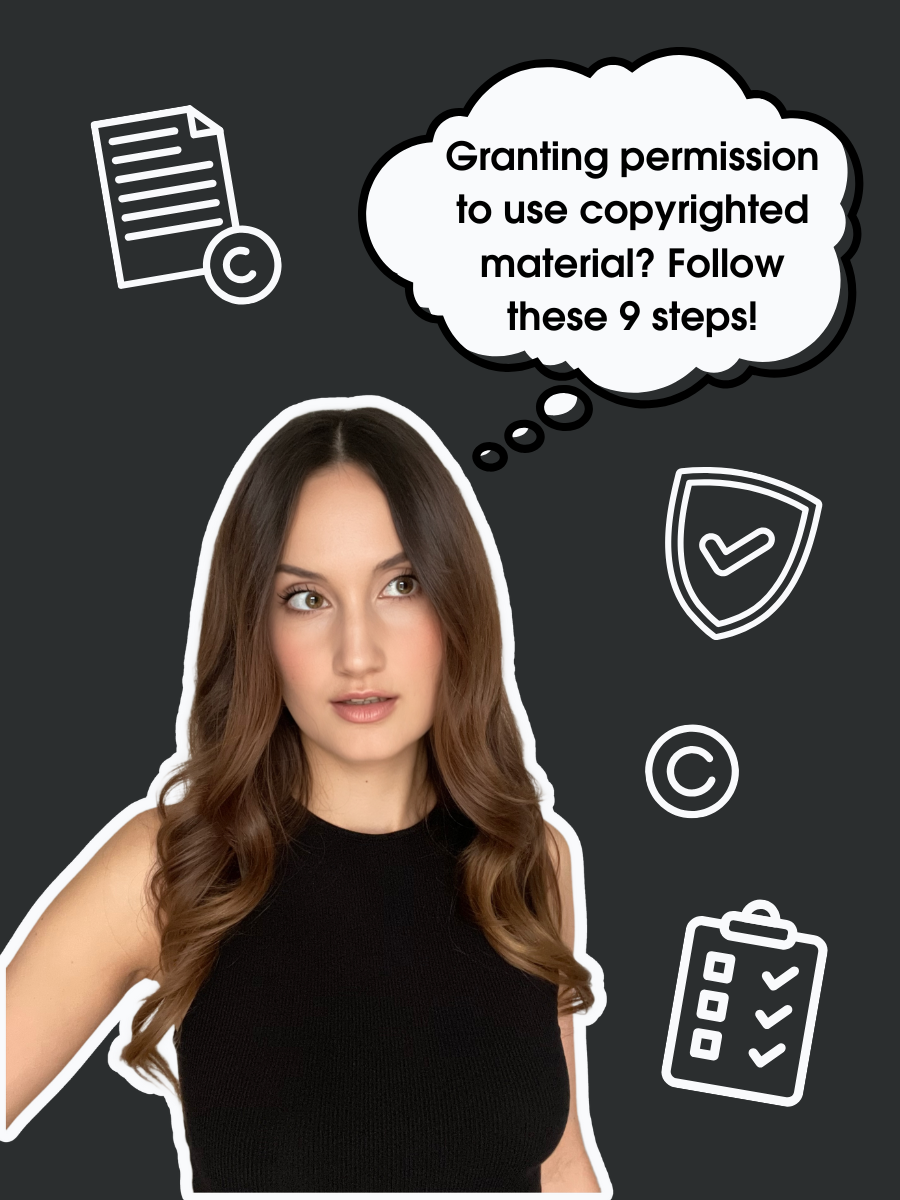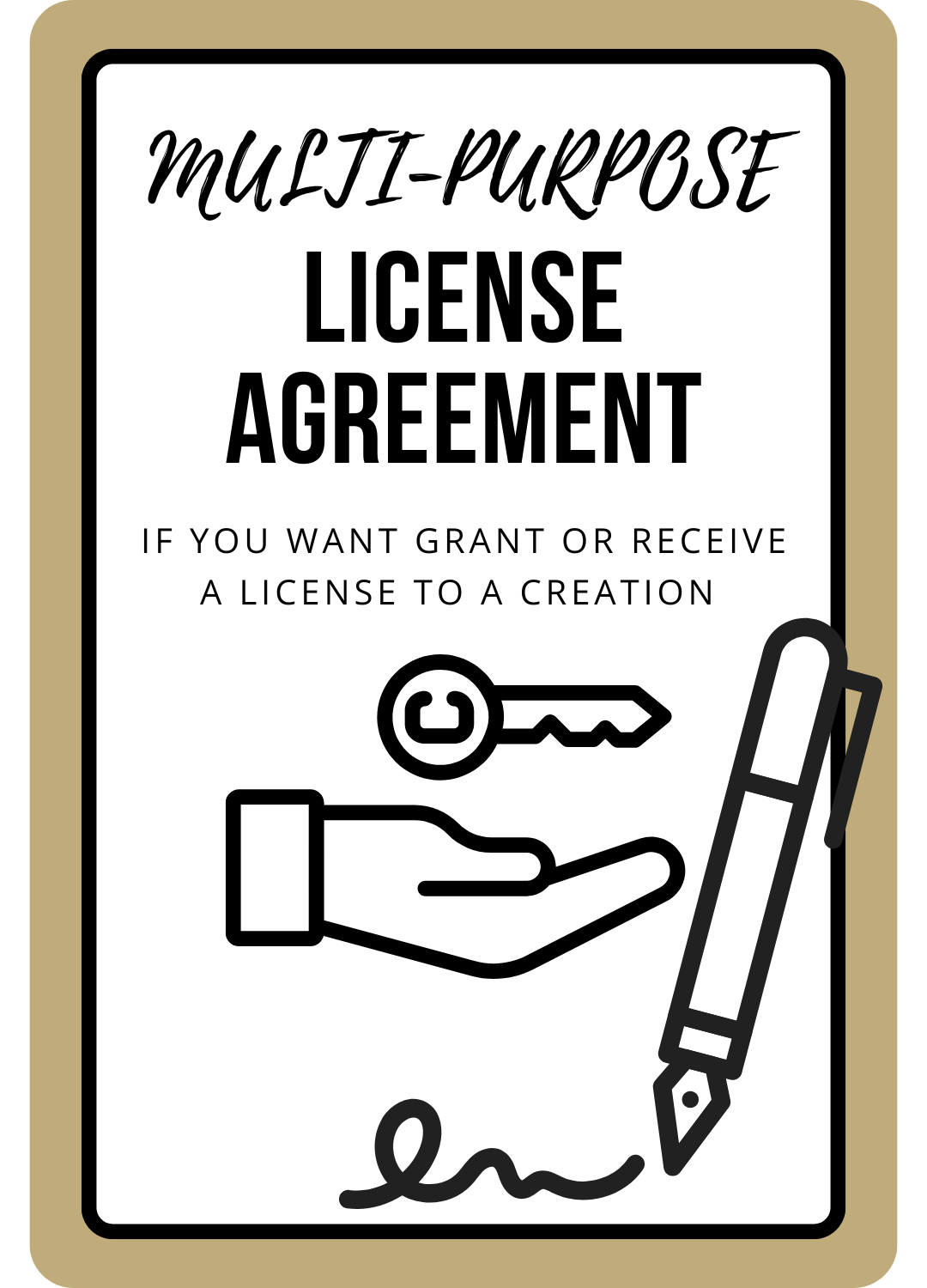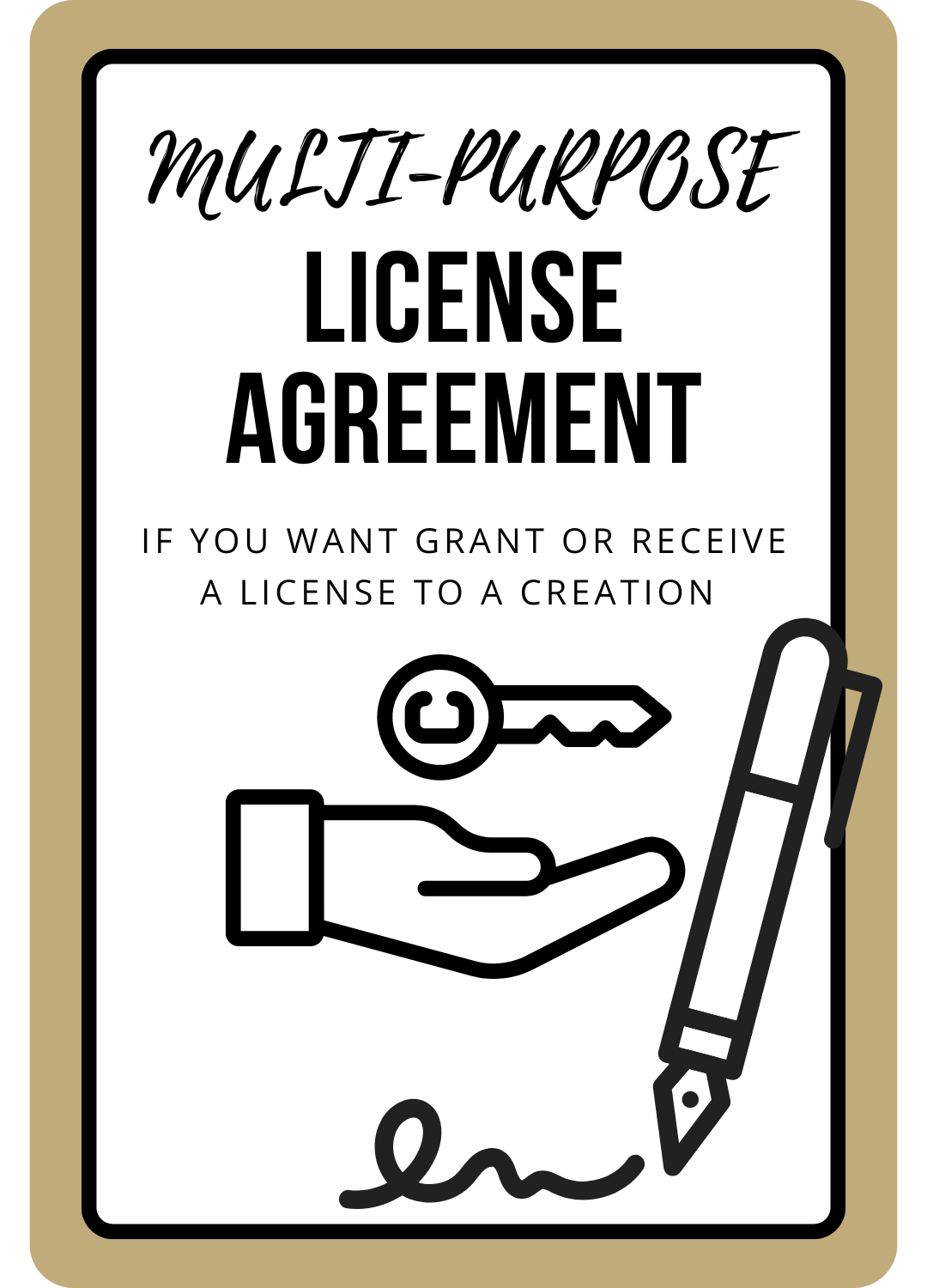Granting Permission to Use Copyrighted Material? Follow These 9 Steps to Protect Your Work
Granting permission to use copyrighted material can boost your business through visibility, collaborations, or extra income. But without the right steps, you risk losing control of your work or missing out on the compensation you deserve.
As a lawyer who helps creators and entrepreneurs like you protect their intellectual property every day, I’ve seen what happens when these details are overlooked — and it’s never pretty.
That’s why I created my licensor-friendly License Agreement Template — so you can safely grant rights to your work without leaving loopholes that cost you money or control.
In this guide, I’ll walk you through the 9 crucial steps you must take before granting permission to use copyrighted material. Follow these when you receive a copyright permission request, and you’ll stay in charge of your work while protecting your income and business.
This post is all about the steps you need to take when granting permission to use copyrighted material — so your work, money, and business stay fully protected.
Granting Permission to Use Copyrighted Material
The 9 Key Steps to Follow When You Receive a Copyright Permission Request
1. Decide How Long Your Materials May Be Used
Before granting permission to use copyrighted material, decide exactly how long the user may use it — a week, a year, or indefinitely. Leaving it vague creates risk.
Example: You receive a copyright permission request from someone to use your video for a “temporary project.” That project keeps getting extended, and suddenly, your work is being used years longer than you ever intended.
Here are 2 safer options I’d suggest:
Specify a clear time period (e.g., 6 months, 1 year).
Grant an indefinite license only if your agreement gives you the explicit right to terminate at any time.
This is exactly why you need a legally binding license agreement, and not just a simple copyright permission statement.
👉 My licensor-friendly License Agreement Template includes this exact clause for licensing periods (plus termination rights) — so even if you grant indefinite rights, you stay in control.
2. Decide for What Purpose(s) Your Materials May Be Used
The next step before granting permission to use copyrighted material is deciding exactly what the user can do with it. As the copyright owner, you want to keep full control when someone else is using copyrighted material you created.
Example: Someone asks to use your photo for a blog. Without clear limits, they later reuse it in a paid ad campaign — something you never agreed to (and that should have come with a higher fee).
To avoid this, always:
Ask for specifics → “What is the blog post about?” / “Which campaign is this for?”
Limit use to the stated purpose only in a contract → no silent expansions into new projects.
Require approval in writing for any new or additional uses.
This is also why you can’t just use a random sample letter granting permission to use copyrighted material you found online. You need a legally binding contract that the licensee agrees to, and only then are they legally bound by your agreements.
👉 My licensor-friendly License Agreement Template makes sure your work can only be used for the exact purpose you approved — nothing more.
3. Decide Where Your Materials May Be Used
It’s not just about how your work is used — you also need to decide where it can appear.
Example: You approve your video for use on someone’s Instagram. Months later, you find it reposted on YouTube, TikTok, and even their website — far beyond what you intended.
This is why you need a legally binding license agreement (not just a copyright permission form) that includes the following:
Specified details up front → the blog title + URL, the specific social handle, or the platform.
Restrict use to those platforms only in your agreement.
Clear prohibition on use elsewhere without your written consent.
👉 My licensor-friendly License Agreement Template includes clear territory and platform restrictions — so your work only shows up where you approve.
4. Establish How You Want to Be Compensated
Granting permission to use copyrighted material should never mean giving it away for free. Decide upfront how you’ll be compensated.
Example: You let someone use your photo for their course. Months later, they sell thousands of enrollments while you earn nothing.
Compensation can take many forms:
Fixed fee → one-time payment for the rights.
Royalties → ongoing payments tied to sales or usage.
Barter value → access to their course, product, or content in return.
Credit → attribution in their publication (mentioning your name, brand, or link).
💡 Tip: Always include clear compensation terms and due dates — and spell out what happens if they don’t compensate you (on time).
👉 My licensor-friendly License Agreement Template covers all of these options — including credit as a form of compensation — and protects you if payments are late or missed.
5. Decide How the User Should Attribute Your Work
Attribution is not optional — it’s your right as the creator. Even if you’re compensated financially, you should still decide how credit is given.
Example: You allow someone to use your image in a blog. Without rules, they post it without mentioning you, and readers assume it’s theirs — costing you visibility and reputation.
Ways you can require attribution:
By name → your personal or business name.
By link → direct link to your website or portfolio.
By tag → linking to your social handle on the platform.
👉 Remember: attribution can also count as a form of compensation (see Step 4). But whether it’s payment or credit, the exact wording and format must be spelled out in your license agreement that the licensee agrees to. A simple copyright permission statement won’t suffice.
That’s why my licensor-friendly License Agreement Template includes attribution clauses — so you always get proper recognition — you’re legally entitled to it.
6. Draft a License Agreement
Once you’ve decided on the key terms (duration, purpose, location, compensation, and attribution), it’s time to put everything in writing. Without a license agreement, your copyright permission statement is just words in an email — not legally enforceable.
Example: A creator agrees by email that your work will only be used in a single project. Months later, you discover it’s been repurposed across multiple platforms. Without a signed agreement, enforcing your rights is an uphill battle.
A strong license agreement should spell out:
The type of license (sole or non-exclusive).
How long the license lasts — and how it can be terminated.
Where and for what purpose your work can be used.
Compensation details (including credit, if applicable).
Restrictions on editing, misuse, or harmful associations.
Your right to revoke if they don’t pay or breach terms.
👉 Want a shortcut? My licensor-friendly License Agreement Template already includes all these essentials (and more), so you don’t have to draft from scratch.
With it, you’ll:
✅ Stay in full control of how your work is used.
✅ Get paid on time (or revoke rights if you don’t).
✅ Protect your reputation by limiting misuse.
✅ Save hours of writing and guesswork.
✅ Give the licensee confidence that everything is legally clear.
Get your ready-to-use License Agreement Template today and protect your work the smart way → Grab it here.
7. Share the License Agreement for Signing
Once your license agreement is drafted, the next step is to get it signed properly. Sending over a PDF and hoping for the best isn’t enough when granting permission to use copyrighted material.
Example: You email your agreement, and the other party never responds. Months later, they deny ever accepting the terms — and you have no signed proof to enforce it. It’s not a legally binding contract, but just a copyright permission form with no legal basis.
To avoid this, always:
Use an e-signature service (like DocuSign or Signaturely).
Keep the process simple → one clear link for them to review and sign.
Be open to minor edits if they request changes you agree with (then resend the updated version for signature).
👉 My licensor-friendly License Agreement Template is designed to work seamlessly with e-signature tools — so you can send, sign, and protect your work in minutes.
8. Keep Track of How Your Materials Are Used
Granting permission to use copyrighted material isn’t the end of the story — you also need to monitor how your work is actually being used.
Example: You license your photo for a blog. Later, you find it in a paid Facebook ad you never approved. Without monitoring, you may never catch the misuse.
Ways to track your materials after granting copyright permission:
Google reverse image search for photos.
Set up alerts (Google Alerts, Mention) for your name or work title.
Ask for updates → your license agreement can require the licensee to inform you of where and how they’re using your work.
💡 Tip: Don’t rely only on trust. Build in information rights so you can request proof of how your materials are used at any time.
👉 My License Agreement Template already includes an ironclad information rights clause, so the licensee is legally bound to give you that information.
9. Keep Detailed Records of All Communications
Your protection doesn’t stop at the agreement itself — you also need a clear paper trail.
Example: A client claims they were allowed to extend usage “informally.” Without written proof of your terms, it’s their word against yours.
Best practices for recordkeeping:
Save your signed license agreement in a secure folder.
Keep all related emails (extensions, payment reminders, amendments).
Use a tracker (Excel or contract management software) if you grant multiple licenses.
💡 Tip: The more organized your records, the stronger your position if someone ever breaches your license.
The Ultimate License Agreement (Not Just a Copyright Permission Statement)
Granting permission to use copyrighted material can open amazing opportunities — but only if you take the right steps to protect yourself. Without clear terms, you risk losing control of your work, missing out on fair compensation, or even damaging your reputation.
The safest way to stay in charge is with a solid license agreement that covers every detail: duration, purpose, location, compensation, attribution, and your right to revoke if terms aren’t met.
👉 That’s exactly why I created my licensor-friendly License Agreement Template. With it, you can:
✅ Grant permission with confidence.
✅ Get paid on time (or revoke rights if you don’t).
✅ Ensure proper credit every time your work is used.
✅ Protect your IP, reputation, and income — in one document.
👉 Grab your License Agreement Template here and protect your work before you say “yes” to any permission request.
Bonus: How to Get Copyright Permission for Images, videos, and other copyright Materials From Someone Else
So far, we’ve covered what to do when you’re granting permission to use copyrighted material of your own. But what if you’re on the other side — and need to ask someone else for copyright permission?
The rules are just as important. A vague or poorly written copyright permission request can lead to confusion, denied access, or even legal trouble down the road.
👉 To make it easy, I created a free Copyright Permission Request Email Template you can start using right away. You’ll get it instantly when you sign up for my newsletter ⬇️
Want to dive deeper? Don’t miss my full guide here: 7+ (Legal) Essentials for Your Copyright Permission Request Email.
This post was all about the simple steps to take when granting permission to use copyrighted material to keep your materials, money, and business protected.
Looking for more guidance? Check out these related posts:






